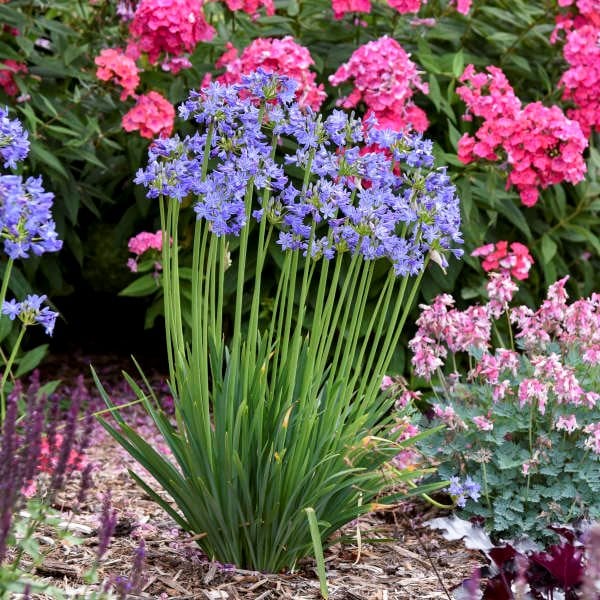Mastering the Art of Agapanthus Treatment: Essential Actions for Healthy And Balanced Growth and Lively Blooms
In the realm of cultivation, the cultivation of agapanthus stands as a gratifying undertaking for those who look for to nurture these elegant blooming plants. From selecting the ideal variety to mastering pruning techniques, the trip in the direction of cultivating flourishing agapanthus plants is multifaceted and holds the key to opening the full capacity of these agricultural gems.

Choosing the Right Agapanthus Range

When selecting the ideal Agapanthus variety for your garden, take into consideration variables such as environment viability, bloom shade, and growth behavior. Agapanthus, generally referred to as Lily of the Nile or African lily, comes in a range of colors varying from tones of blue and purple to white. Select a bloom color that enhances your existing yard scheme to create an unified landscape. In addition, take into consideration the environment in your area to make sure the Agapanthus selection you pick can grow in your specific conditions. Some selections are much more tolerant of cool temperature levels, while others prefer warmer environments. Understanding the development practice of various Agapanthus varieties is critical for proper positioning within your garden. Some selections have a clumping development behavior, perfect for containers or borders, while others have an even more dispersing nature, ideal for ground cover or mass growings. By carefully reviewing these elements, you can pick the best Agapanthus variety to enhance the beauty of your yard.
Suitable Growing Conditions
Thinking about the ideal ecological demands is essential for successful Agapanthus growing. Agapanthus plants are sensitive to chilly temperature levels and must be secured from frost during wintertime months.
To make certain healthy development and dynamic blooms, plant Agapanthus light bulbs at a deepness of about 2-4 inches and room them 8-12 inches apart. Mulching around the base of the plants aids preserve dampness and subdues weed growth.
Watering and Fertilizing Tips
Preserving appropriate moisture degrees and giving essential nutrients are crucial elements in the treatment routine for Agapanthus plants. It is essential to strike an equilibrium when it comes to watering Agapanthus. These plants like regularly wet dirt yet are susceptible to root rot if overwatered. Throughout the next expanding season, water deeply once a week, making certain the dirt is well-draining to stop waterlogging. In hotter environments or throughout periods of dry spell, more regular watering may be necessary to maintain the dirt equally wet. Nonetheless, minimize watering in the winter months to avoid water logged conditions.
Fertilizing Agapanthus is vital for advertising healthy growth and prolific blossoms. Apply a well balanced fertilizer, such as a 10-10-10 formula, in the early springtime as new pop over to this site growth arises. By complying with these watering and fertilizing tips, you can ensure your Agapanthus plants grow and create vivid, lasting flowers.
Trimming Techniques for Agapanthus
Trimming Agapanthus plants at the appropriate times and with proper techniques is critical for preserving their health and wellness and promoting optimum growth and blooming. The perfect time to trim Agapanthus is in late wintertime or early spring prior to brand-new development arises.
Deadheading invested blossoms can additionally reroute the plant's power into producing even more blooms instead than setting seeds. If you desire to collect seeds for breeding, leave some blossoms to dry and mature on the plant.
Remember to use clean, sharp devices to make accurate cuts and reduce the danger of introducing conditions. Agapanthus. Regular trimming will certainly aid maintain your Agapanthus looking healthy and balanced and cool while ensuring a plentiful display screen of gorgeous blooms
Handling Common Parasites and Conditions
After ensuring proper trimming strategies for Agapanthus, it is essential to attend to common insects and conditions that can influence the health and wellness and vitality of these plants. One typical pest that impacts Agapanthus is the Agapanthus gall midge.
Additionally, Agapanthus plants can experience from root rot if they are grown in poorly draining pipes dirt. By being cautious and taking prompt action against diseases and pests, you can help your Agapanthus plants thrive and generate lively flowers. Agapanthus.

Conclusion
Finally, understanding the art of agapanthus care involves picking the appropriate range, giving perfect growing conditions, appropriate watering and fertilizing, ideal pruning methods, and addressing usual pests and illness. By adhering to these essential actions, you try this can make certain healthy and balanced development and dynamic flowers for your agapanthus plants. Keep in mind to consistently keep an eye on and keep your plants to advertise their general wellness and longevity.
To make sure healthy growth and lively blooms, plant Agapanthus bulbs at a deepness of concerning 2-4 inches and space them 8-12 inches apart. By complying with these watering and fertilizing pointers, you can ensure your Agapanthus plants prosper and produce vivid, lasting flowers.
One usual insect that impacts Agapanthus is the Agapanthus gall midget. Additionally, Agapanthus plants can experience from origin rot if they are grown in poorly draining soil. By following these necessary steps, you can ensure healthy and balanced development and vibrant blossoms for your agapanthus plants.